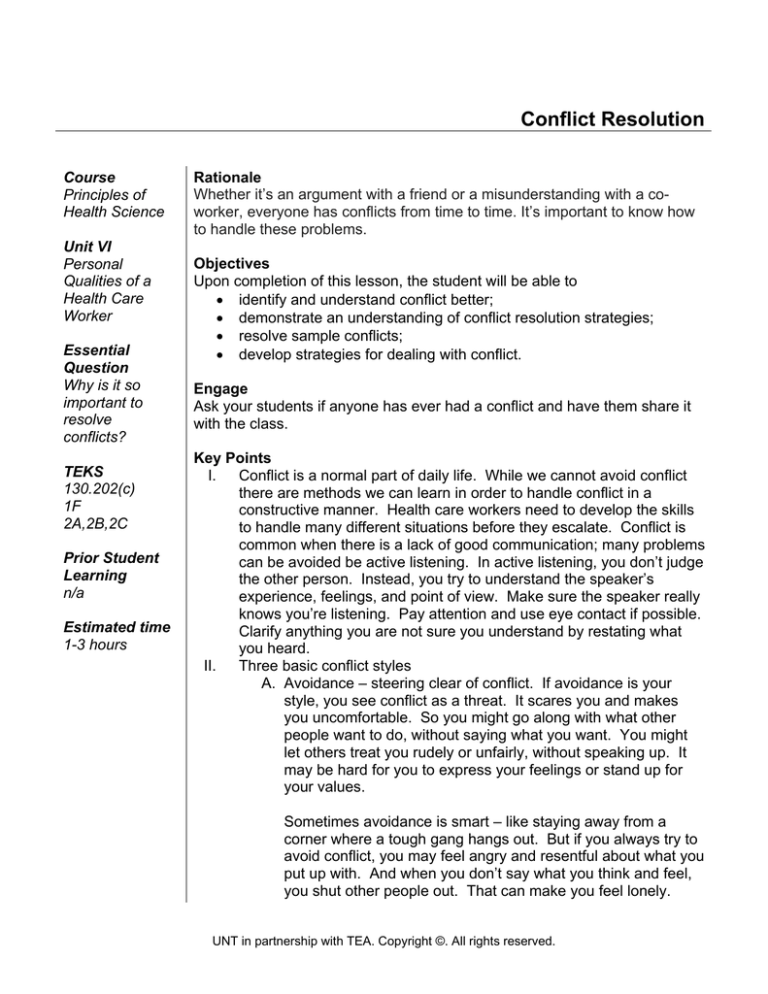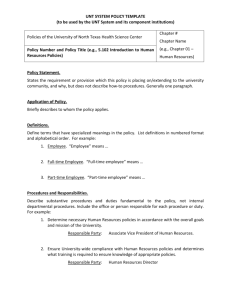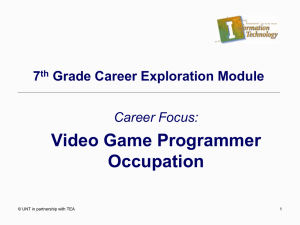Conflict Resolution
advertisement

Conflict Resolution Course Principles of Health Science Unit VI Personal Qualities of a Health Care Worker Essential Question Why is it so important to resolve conflicts? TEKS 130.202(c) 1F 2A,2B,2C Prior Student Learning n/a Estimated time 1-3 hours Rationale Whether it’s an argument with a friend or a misunderstanding with a coworker, everyone has conflicts from time to time. It’s important to know how to handle these problems. Objectives Upon completion of this lesson, the student will be able to identify and understand conflict better; demonstrate an understanding of conflict resolution strategies; resolve sample conflicts; develop strategies for dealing with conflict. Engage Ask your students if anyone has ever had a conflict and have them share it with the class. Key Points I. Conflict is a normal part of daily life. While we cannot avoid conflict there are methods we can learn in order to handle conflict in a constructive manner. Health care workers need to develop the skills to handle many different situations before they escalate. Conflict is common when there is a lack of good communication; many problems can be avoided be active listening. In active listening, you don’t judge the other person. Instead, you try to understand the speaker’s experience, feelings, and point of view. Make sure the speaker really knows you’re listening. Pay attention and use eye contact if possible. Clarify anything you are not sure you understand by restating what you heard. II. Three basic conflict styles A. Avoidance – steering clear of conflict. If avoidance is your style, you see conflict as a threat. It scares you and makes you uncomfortable. So you might go along with what other people want to do, without saying what you want. You might let others treat you rudely or unfairly, without speaking up. It may be hard for you to express your feelings or stand up for your values. Sometimes avoidance is smart – like staying away from a corner where a tough gang hangs out. But if you always try to avoid conflict, you may feel angry and resentful about what you put up with. And when you don’t say what you think and feel, you shut other people out. That can make you feel lonely. UNT in partnership with TEA. Copyright ©. All rights reserved. B. Confrontation – a tough, aggressive, in-your-face approach to conflict. If confrontation is your style, you see conflict as a battle, and you want to win. You tend to jump on anybody who disagrees with you or criticizes you. You argue, you try to dominate, you threaten, and you may get abusive—either physically, by fighting, or verbally, by insults or sarcasm. Sometimes confrontation is necessary—for instance, if someone attacks you physically. But if you make a habit of being confrontational, you’ll get into a lot of fights and a lot of trouble. Other people may avoid you. You may miss a lot of chances to learn about others and about yourself, because you don’t talk about what you—or others—really think and feel. C. Problem Solving—working to find solutions to conflict. If problem solving is your style, you’re not threatened by conflict, and you don’t fear it—you see it as a natural part of life. You’re a good listener, you freely state your own feelings and opinions, and you’re willing to compromise. You enjoy the give-and-take that happens when people work out problems together. You believe that when conflict occurs, it’s possible for everyone to win. III. If you’re a problem solver, you probably get along with many different people. You don’t waste your energy fighting, and you don’t get hung up on feelings of resentment. You know yourself pretty well, and you enjoy getting to know others. Problem solving takes skills. Having these skills makes you feel confident. Four-step model for problem solving A. Find a good time and place to talk – this means choosing a time when all parties are calm and ready to talk, and meeting in a quiet and private place. 1. Set the following ground rules (verbal or non-verbal) a. No interrupting b. No name-calling c. No put downs d. Tell the truth B. Identify the problem or issue 1. Let each person say what happened 2. Focus on the problem, not on personalities 3. Use active listening and “I” statements 4. Avoid communication blockers C. Brainstorm for solutions 1. Let each person suggest ways to solve the problem or address the issue 2. Listen to each other without judging UNT in partnership with TEA. Copyright ©. All rights reserved. 3. Be willing to compromise D. Choose a solution and agree upon it 1. Consider all the options; evaluate pros and cons 2. Decide on one option that everyone can agree on IV. “I” statements are designed to express and take responsibility for your feelings rather than blaming others. There are four steps to developing an “I” statement. The focus is on the action or the circumstance you want changed, not on the person. E. Tell the person, “I have a problem.” F. Make a non-threatening description of the problem. G. Tell the person how you feel about the problem. H. Let reality be the disciplining agent by asking two questions: 1. If you continue the behavior, will it make our relationship better or worse? 2. Do you want our relationship to get better or worse? V. De-escalators I. Stay cool, calm and on center 1. Don’t let the other person throw you off balance and force you into fighting back or escalating the conflict. 2. Breathe slowly and let any negative words or feelings move past you. J. Give the other person some space 1. Look for common interests, common ground. 2. Use a cooling off period. Stop and think about the situation. K. Listen to the other person 1. Say you want to solve this problem together. Let them know you don’t want to fight, but want to understand. 2. Listen for why they are upset and what they need. L. Set your limits with non-blaming statements 1. If you can’t listen, then use non-blaming statements. 2. “You messages” may make people defensive. 3. State how you feel. M. Lighten things up 1. Make a joke to break the cycle of unproductive conflict. 2. Keep a light touch, but don’t use humor to avoid your problems. N. Admit your part - Saying “sorry” or “excuse me” can help diffuse a situation. It doesn’t have to mean that you are wrong and they are right. Activity I. Complete the Conflict Role Play Activity. Assessment Role Play Rubric UNT in partnership with TEA. Copyright ©. All rights reserved. Materials Conflict Role Play Activity Role Play Rubric Accommodations for Learning Differences For enrichment, the student will select a scene from a book, TV show, or movie in which a character has a conflict and does not deal with it constructively. Re-write the scene using problem solving strategies and communication to resolve the conflict. For reinforcement, the student will think about how you handle your anger and communicate your feelings now. What works for you? How could you deal with your anger and problems more constructively? Make a list of ways you can improve in this area. National and State Education Standards National Health Science Standards HLCO2.01 Communications Health Care Workers will know the various methods of giving and obtaining information. They will communicate effectively, both orally and in writing. Adjust communication to other’s ability to understand. Apply the elements of communication using the sender-receiver model. Apply active listening skills using reflection restatement and clarification techniques. Demonstrate courtesy to others including self-introduction. Interpret verbal and nonverbal behaviors to augment communication within the scope of practice. TEKS 130.202(c) (1)(F) formulate responses using precise language to communicate ideas; 130.202(c)(2)A identify components of effective and non-effective communication; and 130.202(c)(2)B demonstrate effective communication skills for responding to the needs of individuals in a diverse society. 130.202(c) (2)(C) evaluate the effectiveness of conflict resolution techniques in various situations. Texas College and Career Readiness Standards English Language Arts II B Understand new vocabulary and concepts and use them accurately in reading, speaking and writing III A Understand elements of communication both in informal group discussions and formal presentations B Develop effective speaking styles for both group and one on one situations UNT in partnership with TEA. Copyright ©. All rights reserved. IV A Apply listening skills as an individual and as a member of a group in a variety of settings B Listen effectively in informal and formal situations Cross Disciplinary Standards I Key Cognitive Skills B Writing across the curriculum C Problem Solving 1. Analyze a situation to identify a problem to be solved 2. Develop and apply multiple strategies to solve a problem UNT in partnership with TEA. Copyright ©. All rights reserved. Conflict Role Play Read the scenarios below. Role play each one three times: once using the avoidance style, once using the confrontational style, and once using the problem solving style. 1. You’re sitting in the no smoking section of a restaurant. Someone sits down at the table right next to yours—also in the no smoking section—and lights up. Cigarette smoke really bothers you. What will you do? Role play the conversation with the smoker. 2. You told your friend Cory you’d like to go out with Lee. Nobody else knows about this and you made Cory promise not to tell. Over the next few days, several people make remarks to you about your liking Lee. The next time you are alone with Cory, you talk about what happened. Role play the conversation. 3. You are standing by your locker, minding your own business, when another student slams into you. You drop your books and bang against your locker. The other student laughs. How do you respond? Role play the exchange. UNT in partnership with TEA. Copyright ©. All rights reserved. Role Play Rubric Student:________________________ Class:____________________________ Title:___________________________ Other Group Members:______________ Date:___________________________ ________________________________ Scoring criteria 3 2 5 4 1 Needs Some Needs Much Excellent Good N/A Improvement Improvement Relates to audience. Provides a fluent rendition of scenario. Role-plays scenario with feeling and expression. Varies intonation. Presents characters appropriately. Gives the scenario its full range. Breaches are easily identified. Scale: 30-35 A Excellent 25-29 B Good 19-24 C Needs Some Improvement 13-18 D Needs Much Improvement 7-12 F Not Appropriate TOTAL= Comments UNT in partnership with TEA. Copyright ©. All rights reserved.




